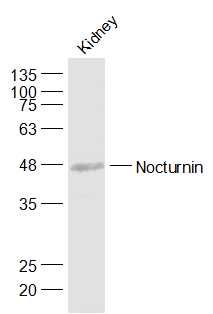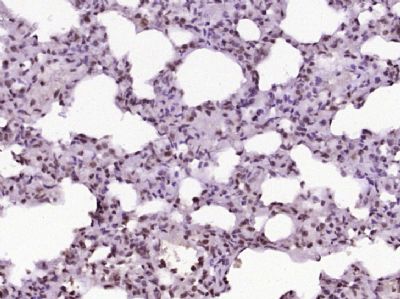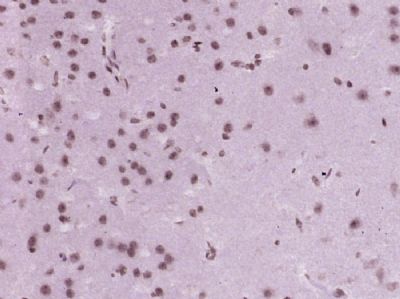Nocturnin Polyclonal Antibody
Purified Rabbit Polyclonal Antibody (Pab)
- 产品详情
- 实验流程
Application
| WB, E |
|---|---|
| Primary Accession | Q9UK39 |
| Reactivity | Rat, Pig |
| Host | Rabbit |
| Clonality | Polyclonal |
| Calculated MW | 48196 Da |
| Physical State | Liquid |
| Immunogen | KLH conjugated synthetic peptide derived from human Nocturnin |
| Epitope Specificity | 91-190/431 |
| Isotype | IgG |
| Purity | affinity purified by Protein A |
| Buffer | 0.01M TBS (pH7.4) with 1% BSA, 0.02% Proclin300 and 50% Glycerol. |
| SIMILARITY | Belongs to the CCR4/nocturin family. |
| Important Note | This product as supplied is intended for research use only, not for use in human, therapeutic or diagnostic applications. |
| Background Descriptions | Nocturnin is a 431 amino acid circadian deadenylase protein that is expressed in a broad range of tissues with greatest abundance in the liver, kidney and testis. Nocturnin plays a role in circadian regulation as well as diet-induced obesity. The mRNA abundance of Nocturnin exhibits circadian rhythmicity, peaking after dusk in photoreceptors, spleen, heart, kidney and liver. Nocturnin is thought to be responisble for turning off genes that are involved in circadian regulation. In Xenopus retinal photoreceptor cells, the rhythmic regulation of Nocturnin is thought to be controlled by phosphorylated CREB. Mice lacking Nocturnin remain lean on high fat diets with a reduction in visceral fat, which suggests that this protein may also be responsible for lipid metabolism and fat storage. |
| Gene ID | 25819 |
|---|---|
| Other Names | Nocturnin {ECO:0000312|HGNC:HGNC:14254}, 3.1.3.-, Carbon catabolite repression 4-like protein, NOCT (HGNC:14254), CCR4, CCRN4L, NOC |
| Dilution | WB=1:500-2000,ELISA=1:5000-10000 |
| Format | 0.01M TBS(pH7.4) with 1% BSA, 0.09% (W/V) sodium azide and 50% Glyce |
| Storage | Store at -20 °C for one year. Avoid repeated freeze/thaw cycles. When reconstituted in sterile pH 7.4 0.01M PBS or diluent of antibody the antibody is stable for at least two weeks at 2-4 °C. |
| Name | NOCT (HGNC:14254) |
|---|---|
| Synonyms | CCR4, CCRN4L, NOC |
| Function | Phosphatase which catalyzes the conversion of NADP(+) to NAD(+) and of NADPH to NADH (PubMed:31147539). Shows a small preference for NADPH over NADP(+) (PubMed:31147539). Represses translation and promotes degradation of target mRNA molecules (PubMed:29860338). Plays an important role in post-transcriptional regulation of metabolic genes under circadian control (By similarity). Exerts a rhythmic post- transcriptional control of genes necessary for metabolic functions including nutrient absorption, glucose/insulin sensitivity, lipid metabolism, adipogenesis, inflammation and osteogenesis (By similarity). Plays an important role in favoring adipogenesis over osteoblastogenesis and acts as a key regulator of the adipogenesis/osteogenesis balance (By similarity). Promotes adipogenesis by facilitating PPARG nuclear translocation which activates its transcriptional activity (By similarity). Regulates circadian expression of NOS2 in the liver and negatively regulates the circadian expression of IGF1 in the bone (By similarity). Critical for proper development of early embryos (By similarity). |
| Cellular Location | Cytoplasm {ECO:0000250|UniProtKB:O35710}. Nucleus {ECO:0000250|UniProtKB:O35710}. Cytoplasm, perinuclear region {ECO:0000250|UniProtKB:O35710}. Mitochondrion |
| Tissue Location | Adipose tissue. Expression is higher in subcutaneous adipose tissue as compared to visceral adipose tissue |
Research Areas
For Research Use Only. Not For Use In Diagnostic Procedures.
Application Protocols
Provided below are standard protocols that you may find useful for product applications.
终于等到您。ABCEPTA(百远生物)抗体产品。
点击下方“我要评价 ”按钮提交您的反馈信息,您的反馈和评价是我们最宝贵的财富之一,
我们将在1-3个工作日内处理您的反馈信息。
如有疑问,联系:0512-88856768 tech-china@abcepta.com.
¥ 1,500.00
Cat# AP54504























 癌症的基本特征包括细胞增殖、血管生成、迁移、凋亡逃避机制和细胞永生等。找到癌症发生过程中这些通路的关键标记物和对应的抗体用于检测至关重要。
癌症的基本特征包括细胞增殖、血管生成、迁移、凋亡逃避机制和细胞永生等。找到癌症发生过程中这些通路的关键标记物和对应的抗体用于检测至关重要。 为您推荐一个泛素化位点预测神器——泛素化分析工具,可以为您的蛋白的泛素化位点作出预测和评分。
为您推荐一个泛素化位点预测神器——泛素化分析工具,可以为您的蛋白的泛素化位点作出预测和评分。 细胞自噬受体图形绘图工具为你的蛋白的细胞受体结合位点作出预测和评分,识别结合到自噬通路中的蛋白是非常重要的,便于让我们理解自噬在正常生理、病理过程中的作用,如发育、细胞分化、神经退化性疾病、压力条件下、感染和癌症。
细胞自噬受体图形绘图工具为你的蛋白的细胞受体结合位点作出预测和评分,识别结合到自噬通路中的蛋白是非常重要的,便于让我们理解自噬在正常生理、病理过程中的作用,如发育、细胞分化、神经退化性疾病、压力条件下、感染和癌症。








